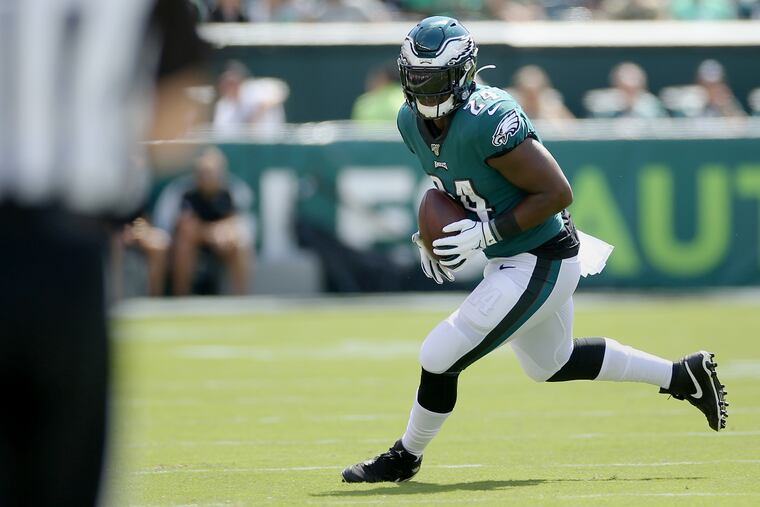Among Darren Sproles, Miles Sanders, and Jordan Howard, the Eagles’ No. 1 running back is ... | Mike Sielski
It's a trick question. The Eagles don't have a No. 1 running back, and if their plan works, they won't need one.

Once you get past the 17-point deficit that the Eagles spotted to an inferior opponent, the most surprising part of their 32-27 victory Sunday over the Redskins might have been the strategy they employed to ignite the comeback.
Remember: At halftime, they were still down, 20-7, having just handed Washington a field goal after a silly offside penalty by defensive end Derek Barnett, so it was hardly a certainty that they would rally.
One might have expected coach Doug Pederson, in the pursuit of big plays and quick points, to have Carson Wentz throw often, and the Eagles did begin the second half with a 12-play drive, capped by a touchdown pass from Wentz to Alshon Jeffery, to cut the Redskins’ lead to six. But the drive defied that expectation; Wentz wasn’t its primary engine. Nine of those 12 plays were runs: one quarterback sneak by Wentz, four handoffs to Darren Sproles, and four handoffs to rookie Miles Sanders.
What wasn’t surprising about that possession was the manner in which Pederson used his running backs. If you were to ask, based on Sunday’s game, who the Eagles’ No. 1 running back is, you could come up with one of three answers. You might say Sproles, who had 16 touches in the game: nine carries, three catches, four punt returns. You might say Sanders, who had 11 carries and would have scored a 21-yard touchdown had a dubious holding penalty by J.J. Arcega-Whiteside not nullified it. Or you might say Jordan Howard, who was the most productive of the three, gaining 44 yards on just six attempts and carrying the ball five times on the Eagles’ final possession, a 19-play drive that melted away nearly nine minutes of game time.
» READ MORE: Eagles lean on 36-year-old Darren Sproles to get ground game going against Redskins
Pederson himself probably wouldn’t bother answering the question. More than three seasons into his NFL head coaching career, he and player-personnel chief Howie Roseman have stuck to the same philosophy when it comes to building a backfield: There’s no need to have one clear-cut No. 1 guy and, in turn, to allocate major salary-cap space to a fungible position.
The Cowboys didn’t follow that thinking with Ezekiel Elliott. The Giants didn’t follow it with Saquon Barkley. Those teams rely on those players in every game situation, early, late, whatever, and have paid or will pay them accordingly. The Eagles go the other way.
“When we put the run game together … we think about the backs and who is going to be in on certain plays, and it’s just kind of the way the game went, the type of running game that it became,” Pederson said Monday. “You can see how dynamic that can be, and we’re just going to continue to work it that way. Sometimes it’s the hot hand, but sometimes it’s based on [the] game plan and who is in at that particular time.”
Sunday was an example of the strategy at its best, but it’s fair to characterize its results as mixed since Pederson became the head coach. The approach worked splendidly in 2017, particularly after the Eagles acquired Jay Ajayi from the Miami Dolphins midway through that season. Their backfield depth was never more evident than in Super Bowl LII, when LeGarrette Blount rushed for 90 yards and a touchdown, Ajayi gained 57 yards on just nine carries, and Corey Clement caught four passes for 100 yards and a touchdown.
They never had that depth in 2016, and they lacked it last season, too. Ajayi, Clement, and Sproles got hurt, and Josh Adams and Wendell Smallwood weren’t capable of picking up the slack. That regression contributed to the Eagles’ squandering late leads in losses to the Titans and Vikings, and it led Roseman to trade for Howard, use a second-round pick on Sanders, re-sign Sproles, and reportedly explore trading for the Chargers’ Melvin Gordon.
There’s enough overlap among the trio’s skills that Pederson can have two backs carry out the same task, and there’s enough variety that he can use one back in a situation particularly suited for him. “They’re really running hard – Sproles, too,” tackle Lane Johnson said. “Jordan’s a very savvy back, very patient, and he’s kind of a workhorse. He’s a grinder. Miles is one cut away from making somebody look silly.” Sproles and Sanders are adept in blitz-pickup and better receivers than Howard. Sproles and Howard are, at the moment, better at running between the tackles than Sanders. Howard generally gains more yards after contact. Sanders is faster. Each has a place where he fits.
Pederson’s responsibility is to make sure that all three of them stay fresh and happy, that he’s using the right back at the right time. He seemed to lean on Sproles more Sunday, including on a misbegotten third-and-1 call in which he hustled Sproles on to the field as the play clock ticked down, then had Wentz pitch it to him. The play lost 2 yards. Sanders failed to burrow into the end zone on two carries inside the 3-yard line in the third quarter. Howard was invisible until that final drive. But then, the game never came down to just one of them. That’s the plan. That’s the point.
Special Offer: Bleed green? Save green! Hustle up, Birds fans! Unlock unlimited digital access to Inquirer.com for just 70¢ for 8 weeks. Get pumped for the season. Subscribe today!